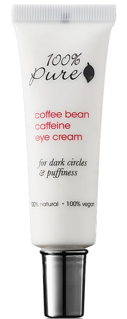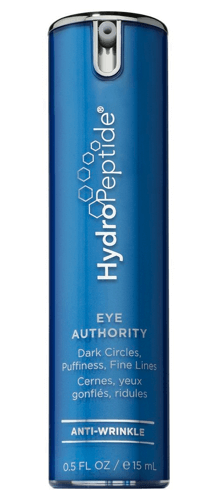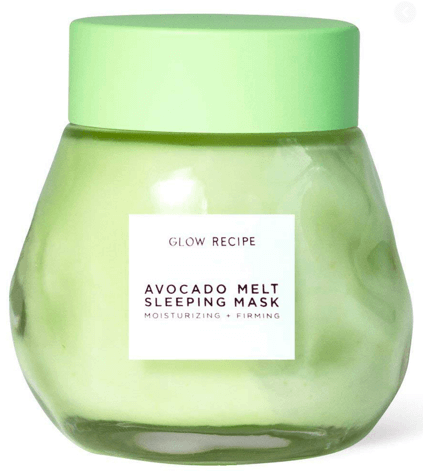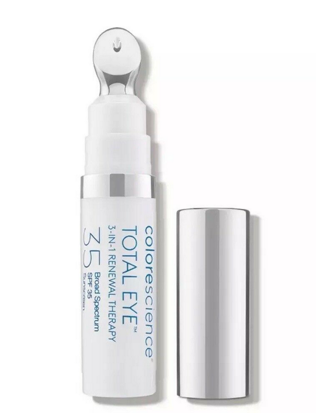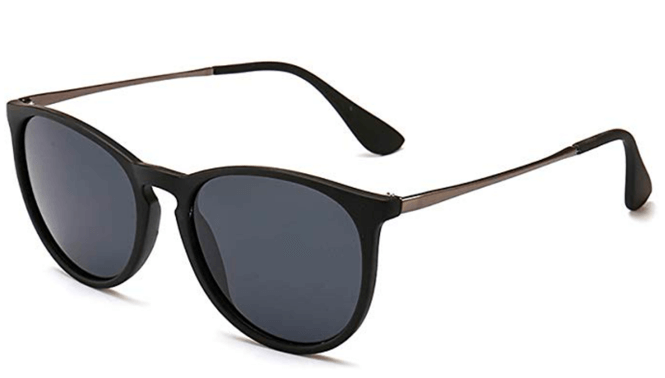Dark Circles:
Causes, Treatments, & Top Ingredients
GHS ONE-LINER: Darker color below both eyes
Dark circles are those pesky under-eye shadows or discoloration that appears directly under your eye. Sometimes, they’re a dead giveaway that you had a long night out or it’s the reason people seem to think you look tired all the time (a roundabout way of saying you look bad) or that you appear to have aged. But it turns out there could be a lot more causing your dark circles than just an active social life or stressful work life.
What Causes Dark Circles?
Genetics
This is the most common cause of dark circles. So, the next time your family looks at your eyes and tells you to get more sleep, let them know they might actually be the cause of the below types of dark circles you may be suffering from.
- Genetic periorbital hyperpigmentation: (aka pigmented dark circles): causes extra melanin to be produced in the skin below your eyes, darkening the area. This typically affects people with genetically darker skin.
- Genetic vascular dark circles: if your genes have blessed you with poor blood circulation or more transparent-looking skin, this may be the cause of your dark circles.
- Genetic structural dark circles: genetics determine your facial bone structure and how deep your tear ducts are. Sometimes, the two combine to create shadows and/or an indentation that looks like dark circles.
Unfortunately, there is nothing currently on the market money to make dark circles caused by genetics go away permanently (a.k.a. there’s no way to buy yourself out of this one). But don’t despair—there’s still a lot you can do to minimize their appearance and keep those eyes bright.

Aging
Wrinkles isn’t the only thing you acquire with age. As you get older, your skin loses collagen (its elasticity - so it gets saggy) and subcutaneous fat (the one time losing fat actually has a negative outcome.) As a result, the skin under your eyes gets thinner which leads to:
- Vascular dark circles: as you age, your skin loses its ability to hide the color (blue, pink, or purple) from the blood vessels under your eye - this makes the area your under eye appear darker because you are literally seeing the blood under the surface of your skin when light gets reflected off your blood vessels.
- Structural dark circles: your skin loses volume with age (especially in the face), causing shadows and creating the illusion of eye bags and dark circles.
While we haven’t found the fountain of youth (or fountain of youthful eyes) yet, there’s a lot you can do to minimize the appearance of dark circles caused by aging.

Sun Damage
The skin around your eyes is some of the thinnest on your body, so it’s extra sensitive to sun exposure. And when it gets hit with sun damage, we see increased blood flow and age spots, resulting in periorbital hyperpigmentation (pigmented dark circles). Unfortunately, you can’t undo the effects of sun damage, so be sure to use preventative measures (it’s never too late to start).

Chronic Eye Rubbing
We get it, you’re tired—but try not to rub those eyes! The skin near your eyes is super delicate, and rubbing it can easily break the blood vessels in the area, causing swelling, inflammation, and—yes—vascular dark circles.

Lack of Sleep
When you don’t get enough sleep, your body produces extra cortisol, which leads to more blood pumping through your veins. And that means those enlarged vessels show through the skin as vascular dark circles. It’s a no-brainer, but we have to say it: find a way to get some more shut-eye (7-9 hours per night, ideally). If need be, try sleeping on your back to avoid constricting blood vessels in your face or sleeping with extra pillows to elevate your head and reduce eyelid swelling.

Lifestyle Choices
Certain lifestyle choices can worsen the appearance of your dark circles. Those of you who engage in the below activities...do everything in moderation so you don’t look like a hot mess:
- Too much caffeine
- Excessive alcohol use
- Smoking
All the above things can cause dehydration, leading to the skin under your eye getting thinner, bringing to light the blood vessels beneath the skin under your eyes, and ultimately resulting in vascular dark circles.

Periorbital Puffiness
This is fancy medicine-speak for bags under your eyes. It’s the annoying swelling that makes your dark circles look even darker. In younger people, periorbital puffiness is usually caused by fluid buildup from illness, allergies, lack of sleep, or excessive salt consumption. The buildup causes increased pressure on the skin and blood vessels, pushing blood vessels closer to the skin’s surface, and making vascular dark circles appear more prominent. However, it doesn’t just affect the young. Periorbital puffiness can also be a result of old age (a.k.a. infraorbital palpebral bags).

Allergies
Allergies can trigger the release of histamines in your body, which cause blood vessels to dilate under your eyes. Allergies can also make your eyes itch, and it’s only natural to rub them—but that rubbing can lead to swelling, inflammation, and broken blood vessels in the eye area. These are all types of vascular dark circles. For allergies, use an under-eye cream in the AM with caffeine (to help shrink swollen blood vessels) and antioxidants (like green tea, which helps reduce inflammation).

Medications
Any medication that causes your blood vessels to dilate will also lead to increased blood flow. When it comes to the delicate area below your eyes, that increased blood flow can show through as vascular dark circles.

Poor Nutrition and Anemia
Vitamin deficiencies (especially vitamin K), protein deficiency, iron deficiency anemia and dehydration can contribute to vascular dark circles. Take a multivitamin to help with vitamin deficiencies. If you lack vitamin K, eat more broccoli, Brussels sprouts, asparagus, kale, cabbage, spinach, blueberries, soybeans, and/or edamame. If you are iron deficient, eat more red meat, seafood, green leafy vegetables, beans, dried fruit, iron-fortified cereal, eggs, and/or whole-grain bread.

Types of Dark Circles
Vascular Dark Circles
Most common for all skin types
Blue, pink, or purple circles from oxygenated blood vessels that show through the thin skin under your eyes - only blue or violet light is reflected through your skin tissue when light passes bounces off your blood vessels
Caused by: genetics, aging, chronic eye-rubbing, lack of sleep, lifestyle choices, periorbital puffiness, allergies, medications, poor nutrition, or anemia
Pigmented Dark Circles
Common in darker skin tones
Brown circles from skin pigmentation - more common in darker skin tones
Caused by: sun damage or genetics
Structural Dark Circles
Contours and shadows caused by your unique facial bone structure, which make the skin under your eye look darker than it actually is
Caused by: aging or genetics
How to Reduce Dark Circles

Use Under-Eye Creams or Serums Daily
After cleansing, apply an eye cream or serum twice a day that contains one or more of the following ingredients: caffeine, vitamin C (ascorbic acid), peptides, retinol, and hesperidin methyl chalcone. These ingredients help brighten the area under your eyes, fight free radical damage, improve cell turnover rate, strengthen the protective barrier of the delicate skin under your eye, and restore skin volume and elasticity by stimulating the production of collagen and elastin.

Hydrate with Humectants Daily
After you’ve applied your eye cream or serum, follow up twice a day with an under-eye moisturizer that contains hyaluronic acid. Hyaluronic acid works to keep the skin under your eyes hydrated, which is essential to anti-aging and as a result, your skin has a more a youthful appearance (bouncy, supple, and plump).

Use an Eye Mask a Few Times a Week for Targeted Treatment
A few times a week after applying your under-eye serum and before applying your under-eye moisturizer, apply an eye mask. Under-eye masks offer targeted therapy to an area where the skin is fragile compared to the rest of our face. When you cover the skin with an eye-mask, you increase the penetration of ingredients, anywhere between 10 to 100 times.

Apply Sunscreen Daily
After moisturizing, always apply sunscreen with an SPF of 15 or higher daily under your eyes (yes, even during the winter, and even when it’s cloudy out) to prevent sun damage- if you will be in the sun for an extended amount of time, reapply sunscreen every 2 hrs. Sun damage causes pigmented dark circles and can worsen genetic periorbital hyperpigmentation.

Invest in UV Protection Sunglasses
Look for a pair of sunglasses that are labeled 100% UV protection or UV 400 protection to efficiently block the sun's rays from harming the delicate skin under your eyes - the skin under your eyes is very thin and as a result, it is extra sensitive to sun exposure.

Avoid Aggressively Rubbing the Skin Under Your Eyes!
When applying eye creams, eye serums, or makeup under your eyes, pat the product from the inner corner of your eye to the outer corner of your eye until it's absorbed - do not rub the product in to absorb! When removing eye makeup, do not aggressively rub the makeup remover wipe or cotton pad back and forth over your lids and underneath your eye.
Check out the GHS 10 Best Products for Reducing Dark Circles.
Our curated list is paraben-free, sulfate-free, and phthalate-free.
GHS Tips
Use a Warm Compress
Apply a washcloth soaked in lukewarm water under your eyes for 15 minutes in the AM or PM. This will temporarily help improve circulation in the area and help get your blood circulating.

Apply Potato Skins
Apply thin slices of potato skin under your eyes for 15-20 mins in the AM. Potatoes contain an enzyme called catecholase that can temporarily naturally lighten your skin. Avoid getting potato juice in your eye.

Use a Cold Compress
Apply any of the below cold compresses under your eyes for 15 minutes. The cold shock will temporarily shrink the dilated/enlarged blood vessels under your eyes and reduce puffiness.
• Chilled teaspoons, green tea bags, or cucumber slices
• An ice roller
• Cucumber under-eye gel patches

Cover with Concealer
Repair with cosmetic camouflage, a.k.a. an under-eye concealer that will hide the evidence of dark circles and even out your skin tone under your eyes.
Learn how to apply concealers correctly for dark circles at Sephora.

Top 6 Ingredients for Reducing Dark Circles
✓ Hyaluronic Acid
- Replenishes moisture
- Strengthens protective barrier
- Supports collagen & elastin
Category: humectant (hydrator)
Treats: vascular or structural dark circles
✓ Vitamin C
- Lightens pigmentation
- Brightens complexion
- Pair with hyaluronic acid
Category: antioxidant
Treats: pigmented dark circles
✓ Peptides
- Stimulates the production of collagen and elastin
- Pair with hyaluronic acid
Category: peptides
Treats: vascular or structural dark circles
✓ Retinol
- Stimulates the production of collagen and elastin
- Pair with hyaluronic acid
Category: retinoid
Treats: vascular or structural dark circles
✓ Caffeine (Topical)
- Temporarily constricts blood vessels
- Pair with hyaluronic acid
Category: plant extract
Treats: vascular dark circles
✓ Hesperidin
- Strengthens weakened capillaries
- Fights inflammation
- Pair with hyaluronic acid
Category: antioxidant, plant extract
Treats: vascular dark circles
FAQs about Dark Circles
Q. What causes dark circles?
- Genetics
- Aging
- Sun damage
- Chronic eye rubbing
- Lack of sleep
- Lifestyle choices
- Periorbital puffiness
- Allergies
- Medications
- Poor nutrition and anemia
 Q. How do you reduce dark circles?
Q. How do you reduce dark circles?- Use under eye creams or serums that contain one or more of the following ingredients: caffeine, vitamin C (ascorbic acid), peptides, retinol, and hesperidin methyl chalcone.
- Hydrate with hyaluronic acid
- Use an eye mask a few times a week
- Apply sunscreen daily
- Invest in UV protection sunglasses
- Avoid aggressively rubbing the skin under your eyes
 Q. Can dark circles be removed permanently?
Q. Can dark circles be removed permanently?It depends. The kind of dark circles that are caused by genetics, age, and sun damage will be with you forever (sorry). However, you can minimize their appearance with the right treatments and/or concealers. On the flipside, if your dark circles are caused by chronic-eye rubbing, medications, allergies, periorbital puffiness, lifestyle choices, poor nutrition, anemia, or lack of sleep, effective treatments may get rid of them once and for all.
 Q. Which concealer is best for hiding my dark circles?
Q. Which concealer is best for hiding my dark circles?- Fair skin: use a concealer with pink tones in it
- Light to medium skin: use a concealer with peach tones in it
- Tan to dark skin: use a concealer with orange tones in it
- Deep dark skin: use a concealer with red tones in it
Shop our favorite concealers at Sephora.

Q. Are dark circles the same as bags?
Nope, they’re different. Bags under your eyes (also known as blepharochalasis) are caused when the skin stretches and then sags. They’re often due to age and good old gravity—two pretty unavoidable things.

Q. Will dark circles go away with sleep?
It depends - if your dark circles are vascular, than they may be appearing from your body producing extra cortisol due to a lack of sleep. If this is the case, then yes, getting 7 to 9 hours of sleep per night will help. However, the majority of vascular dark circles are a result of genetics or aging; and in these cases, getting more sleep will have no effect on them.

Q. Will Botox help dark circles?
It won’t. Botox targets fine lines and wrinkles from facial expressions - it isn’t designed to brighten dark circles. Don’t waste your time and cash on this one!

Q. Will tanning help dark circles?
No, no, no! Sun damage actually causes dark circles—so tanning will only make it worse.

Q. Will ice reduce dark circles?
Ice will only temporarily reduce vascular dark circles. If applied under your eyes for 10-15 minutes, the cold shock from the ice will temporarily shrink discolored and dilated blood vessels.

Related Pages
10 Best Products for Reducing Dark Circles
7 Best Cruelty-Free Products for Reducing Dark Circles
Hyaluronic Acid Skin Care Benefits: All You Need to Know
Vitamin C Skin Care Benefits: All You Need to Know
Retinol Skin Care Benefits: All You Need to Know
Caffeine (Topical) Skin Care Benefits: All You Need to Know
Want More GHS Tips?
It’ll be the best thing to ever slide into your DM's.
